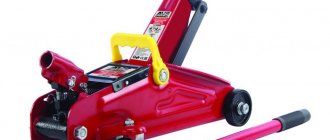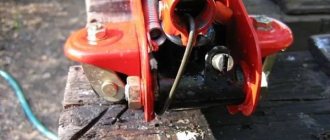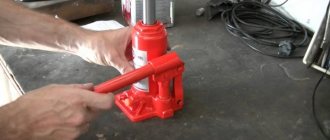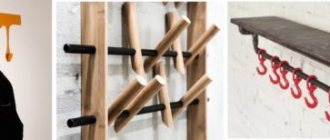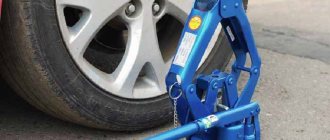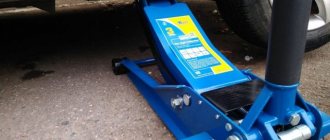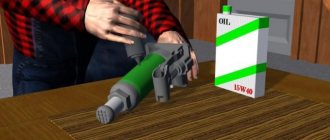The pit traverse is one of the most common types of lifts among owners of both their own car services, workshops and service stations, and ordinary motorists who have their own garage with a special ditch.
Traverse for pit
Its main advantages are obvious - relatively small dimensions and weight, which allows you to easily move it from place to place, ease of maintenance and operation, relatively low price and third-party maintenance costs. It is thanks to this that companies involved in the production of pit traverses are never left without income.
What is this miracle unit? Let's figure it out.
Traverse to the pit - how does it work?
So, pit traverses are a combination of the following elements:
- base, or carriage, on which all other elements are placed. It is a rectangular frame made of high quality steel. It can be additionally equipped with a roller system for moving both along the bottom of the ditch and along its walls (if there are special grooves);
- hydraulic or pneumohydraulic drive located on the carriage and driving the lifting mechanism. It is equipped with an impermeable hose and a pump, which is used to pump up pressure in the system (usually manually, although there are models that are controlled remotely);
Pneumatic traverse for pit
- scissor lift mechanism - a system of cross levers that moves as pressure builds up in the hydraulic system. In this case, the levers move towards each other, simultaneously lifting the platform with the load up. The number and location of levers may vary - depending on the required lifting height and load capacity;
- platform located at the top of the scissor system and directly responsible for lifting the load. Made from high-strength steel with a protective coating. To increase the lifting height, it can be used in conjunction with removable supports in standard or telescopic versions.
And so I present to the public eye my small brainchild. A ditch jack. I wanted to make it for a long time and finally did it. About the device: hydraulic cylinder - 2 tons, rod lift 580 mm, mounted on a frame with wheels. lifts the car by any axle , even in front of at least the rear frame is welded from a 50 by 50 profile, the wall is 2 mm, the wheels are bearings with gearbox 21083, pressed onto the 20th pipe. The cylinder has a double-sided pump - the lifting speed is higher. The frame moves along the corners of the inspection hole. The thing is simple and very convenient. especially for those who repair cars, the price is about 7500 rubles
Manual lift for lifting a car
This device is not a jack in the truest sense of the word. However, this is one of the types of mechanical lift.
The idea of making this device belongs to the author of the YouTube channel “BOBKA TV”.
First of all, we prepare the necessary parts. To do this, we use the following materials: profile pipes, strips of metal and a piece of round pipe (we cut the round pipe blank lengthwise and use one of the resulting halves).
Next, we proceed to the manufacture of a homemade device. We weld a piece of round pipe to a section of professional pipe, as shown in the photo below.
We weld another piece of corrugated pipe to the opposite end of the profile. We weld a stand from a long section of profile pipe to it - it will act as a lever. A handle must be welded to the top of the rack.
Next, install the wheel axle from a threaded rod and weld it. We weld a piece of profile with furniture wheels to the stand.
We clean the welds and start painting. After this we install the support wheels.
The principle of operation of a homemade device is very simple. We rest the trolley against the bottom of the car. Then we press on the lever with our own weight and lift the car. In this case, you no longer need to press the lever.
The step-by-step process of making a homemade rolling jack is shown in the author's video.
New!!! Incredible Life Hack for the Driver! Homemade Car Jack
If you liked this homemade product, you can repeat it. But be sure to use car safety stands.
How to make a reliable lift in the garage with your own hands?
The arrow is made from steel angles, a glass, and a strut.
A bronze bushing is pressed into the glass as a sliding bearing.
The manual winch is the main part of the car lift in the garage.
It is advisable to buy a finished product. You can make a rack-and-pinion crane using available materials. The gearbox is capable of moving large loads.
The sprocket is put on and connected to the worm shaft with a key.
Communities › Kulibin Club › Blog › Tools: DIY garage lift
But making them is not a problem at all, it’s just the ends of the same profile pipe protruding above the corner of the pit.
Stages of work
A homemade car jack is usually small in size and has a simple design. This allows even beginners to make it. Usually the materials for manufacturing are inexpensive, and you only need a small amount of them. They can be found at home, in the garage or shed, or purchased at the store.
To work, you need to prepare a steel tube, a square plate, a nut, a washer and a long bolt, as well as a drawing. The latter is the most difficult part of the job. You can find drawings or draw them yourself. When working on a drawing, you need to indicate the correct dimensions of the parts, and not do everything “by eye”.
The creation itself is not difficult. The basis is a steel tube. The diameter is determined independently; there are no requirements for it. The length of the pipe should be up to 25 cm.
The first step is to attach the tube to the square plate. It needs to be welded and the surface cleaned with a grinding disc.
Place a prepared washer on the pipe, insert a long bolt into it, onto which you must screw a nut in advance.
Once the mechanical screw jack is ready, it can be used when changing the wheels of the car. The lifting occurs due to the nut, and the holding occurs due to the plate, which is the supporting part.
welcome to Russia
DIY garage lift photo
Traverse into the pit with your own hands
Pneumatic traverse for the pit – Metal Forum
hydraulic cylinder kun 80.40 630. connector
Pneumatic traverse 2000 kg TPO 300 in Chernigov, I offer services, car repair shops in Chernigov - 1371290, chernigov.avizinfo.co
Pneumo-hydraulic traverse Trommelberg TXBJ3000P – “Tech-Auto” technical
Other equipment for business, ready-made business, etc.
to the pit with your own hands
Pneumatic axial traverse TPO-600.
How to make a jack for a pit Do it yourself Review of repair methods
Traverse, pit jack for lifting a car
Pneumatic traverse 625 price 33,600 rub.
Pneumatic traverse TPO 300, price - 8,500 UAH, Krivoy Rog, used, advertisement, sell, buy.
Pneumatic traverse for the pit – Metal Forum
Manual car lift (traverse) Silver TS K-2, price RUB 2,242.27, buy in Minsk - Deal.by (ID# 6536118)
TPO 300 U - Traverse - Wheel alignment
Pneumatic traverse for the pit – Metal Forum – Page 2
Do-it-yourself traverse for a pit
MEGA MA-21 at the best price in Spetskomplekt in Murmansk
Security measures
When working with a pneumatic jack, you must strictly comply with the safety requirements specified in the operating instructions. It must be remembered that the jack is not a safety device and is intended only for lifting the car.
In this regard, it is imperative to record:
- car wheels using wheel chocks, which will prevent spontaneous movement of the vehicle during repairs;
- the car body at the required height, using safety stops for this.
In addition, you need to check and make sure that the vehicle's wheels are braked by the parking brake system.
Do not exceed the lifting capacity of the jack. In cases where the air jack is equipped with a safety valve set by the manufacturer to prevent excess load, it is prohibited to change the factory settings.
DIY garage lift
Then take the key, put it on the drive shaft, and secure it. Next, make a ø2 cm hole in the tile for the chain, then pass the chain through the finished hole and close it into a ring. Place another sprocket on the output shaft, this time smaller, and connect them.
Make two more holes ø3 cm in the slab, pass the chain through them, placing it on the smaller key.
The second chain must end with a steel hook capable of supporting the weight of the engine. The operation of the worm structure should proceed as follows.
The following solutions were used as materials. For longitudinal beams, channel No. 8 was used, for transverse beams - channel No. 6, for platforms with holes for guides - corrugated pipe 50x100. The material was selected taking into account the entry of the smaller channel with its edges into the larger one, and the profile pipe into the smaller channel, which ensures additional rigidity of the structure.
Length – 500 mm, width between the edges of the cross beams – 820 mm. The distance between channel No. 6, where the pipe enters, is 340 mm. The distance between the guides is 600 mm. The length of the guides themselves is 700 mm; 32 pipes were used for their manufacture. The lifting beam is made in the form of a kind of profile pipe, which is welded from channels No. 8 and No. 6 - they are inserted into one another. The length of the beam is 1050 mm.
The jack is a two-rod jack, made in China, according to the stated characteristics - 6 tons. For the platform for the jack, 3 pieces of channel No. 6 were taken. A 6 mm reinforcing plate was welded into the end of the platform on the sides. The “wheels” are bearings 180604, size 20x52x21 - 2 pcs. on each of the corners. M20 bolts are used as axles; the part without thread has a length of at least 40 mm and a thickness of 20 mm. 30 mm spacers are inserted between the bearings and the frame. They are here because the inspection hole for which this structure is made is filled unevenly, with a floating distance between the edges. In order for the traverse to move more smoothly along the pit, horizontal guides are provided in the form of small bearings 608 (they are in the photo where the structure is placed on the pit).
also made several pneumatic traverses for a local service station a little earlier:
The device is made according to the same principle, but with some difference - with an air spring instead of a jack. A screw from a jack is welded to its body, due to which the height of the pick-up can be adjusted.
What is a jack used for? Types of jacks
The main function of a jack is to lift a car wheel in order to replace it or a tire. The jack is used to independently replace car wheels in the absence of repair services. Also, sometimes you have to crawl under the bottom of the car in order to carry out repair work. The jack will come in handy in this case too.
Outside of the automotive field, jacks are often used to install structures at the required level during construction and repair work, when lifting loads in warehouses and spare parts in workshops.
You can read about how the driveshaft crosspiece is replaced on a VAZ-2107 in a detailed article by our author.
You may also be interested in information on how to choose and securely fasten wheel covers with your own hands.
The important characteristics of the jack are listed below.
- Load capacity . Each of the jacks has limitations on this parameter. When manufacturing the device, it is necessary to take into account the weight of the vehicle. It is also necessary to take into account the weight of the cargo in the luggage compartment.
- Lifting height . This parameter is especially important for cars with low bottoms. In this case, the lifting height must be acceptable to allow one to climb under the car and carry out repair work.
- Pickup height . This is the height of the instrument. This parameter must be compatible with the vehicle's ground clearance (distance from the surface to the lowest point). This parameter is different for each individual model. It is necessary to select the pick-up height so that it is comfortable to work.
Jacks come in different types depending on the type of drive.
- Mechanical type , in which lifting occurs by pressing the handle. These jacks are intended for infrequent use. Such devices are compact, but require physical effort.
- Hydraulic type . Similar to the previous one, but requires less effort. The wheel rises due to the pressure created by the working fluid. Great for frequent use.
- Pneumatic type . The device operates using compressed gases. Gas cylinders are required for use. The gas creates pressure, the chamber increases in size, and the car begins to rise. No physical effort is required.
You will find detailed information on how to make your own lift for a passenger car in the material from our specialist.
We also recommend reading the most informative article about the types of manual winches for cars, their features and selection factors.
Our expert will tell you in detail how to make a working winch from a starter with your own hands step by step.
You can read information about making a slipway for body work with your own hands in the article by our specialist.
According to the operating principle, jacks are divided into screw, rack and pinion, pneumatic and hydraulic. Jacks can be stationary, mobile or portable. Homemade devices are most often portable, as they are small in size. Stationary jacks are intended for large loads and are rarely of interest to car owners.
Recommendations and tips
The most important question remains. Is it even worth making the jack yourself? The answers to it may be different, however, after weighing all the nuances, you can come to a final conclusion. First, it’s worth understanding the cost. It is clear that no one will buy a tool for manufacturing, however, you will need material and some parts that will still have to be purchased. It is quite possible to buy a new factory jack for 5,000 rubles. The expenses for a homemade one will depend on what kind and type it is. So, making a hydraulic one will be the most expensive, but the pneumatic one discussed above is the cheapest.
In general, the cost of a jack is not so much that you have to rack your brains and make it yourself. If you don't care about it, then it's better not to bother with it and buy a new one at the store. But, if the process itself is interesting and you want to make something, then this is a great idea to test your skills. You might even be able to save 1-2 thousand rubles. That is, when there is a desire to do it, try, be smart and achieve results. But if the process of making a jack is not interesting to you, then it is better to postpone this matter.
The main thing to remember is safety measures. Any tool in inexperienced hands can cause serious injury. Also remember to wear safety glasses when working on metal and when welding to protect your eyes.
The other day I came across the topic of electric jacks. Having looked and read about them, I think they are a promising tool for self-repairing a car. In my opinion, it’s very convenient when replacing car wheels. I don’t know about the durability and reliability of these devices. Maybe someone is already using electric jacks? Answer me. Tell me the pros and cons of this device? Of the more or less reliable in my opinion and affordable, I found Varta V-CJ2.10 and Turbo Jack. There is also a Varta complete with an electric impact wrench, but the price tag is 10,000 rubles. I think it’s a little expensive. While driving, I recommend the Turbo Jack GB-A20. Here is a link to the article www.zr.ru/content/article…_nestandartnyje_domkraty/
Comments 4
I don’t like diamond jacks because of their poor stability and small support area. They are designed to work on asphalt; it's not so much fun on the side of the road. And you definitely need a current of at least 20A. I’ve been using a hydraulic rolling one for more than 15 years, and I definitely wouldn’t change it to another one.
This is the second year I've been using a jack produced by ZIL, a 1.5 ton rhombic jack at the end for the wrench head bolt. Screwdriver 18 volt head through a 1/2 bit and voila, 5 seconds the car is raised. Standing pulling the handle or twisting in a half-bent position I’m tired of it. To each his own. I made my choice. I didn’t take the electric jack from above, but invented my own more reliable one. Raises the santafe and focus 3 without any problems. Renault Sandero lifts the entire side at once. You can change 2 wheels at once.
I repeat, I did not like the poor stability on any surface other than asphalt. The rolling support area is much larger and does not require additional devices such as a screwdriver (I basically don’t have one). And since I jack up the car twice a year, “pulling the handle” is not difficult for me.
Yes, but the price of a more or less normal rolling jack is 8000 rubles and above. The price of a ZIL rack jack is 1500 kg. 1200 rubles and the price of a screwdriver if you don’t have one, 18-volt 3000-4500 rubles is more or less normal. I agree about stability, but I use it most often on concrete, and if in the countryside, then I lay 20 by 20 tiles. Well, if you install it correctly, then everything is fine on any surface. Factory car jacks Almost all of them are rhombic. It’s still not convenient to carry a rolling jack if it’s not small. And if it’s small, then it’s most likely made in China and leaves much to be desired in terms of quality. My rolling jack served for 1.5 years and died. The valve on the piston mechanism died. To each his own .I made my choice. I don’t want to convince you of your choice either. Some people use inflatable jacks through a compressor and it’s also not possible to convince them.
>
Stages of work
A homemade car jack is usually small in size and has a simple design. This allows even beginners to make it. Usually the materials for manufacturing are inexpensive, and you only need a small amount of them. They can be found at home, in the garage or shed, or purchased at the store.
To work, you need to prepare a steel tube, a square plate, a nut, a washer and a long bolt, as well as a drawing. The latter is the most difficult part of the job. You can find drawings or draw them yourself. When working on a drawing, you need to indicate the correct dimensions of the parts, and not do everything “by eye”.
The creation itself is not difficult. The basis is a steel tube. The diameter is determined independently; there are no requirements for it. The length of the pipe should be up to 25 cm.
The first step is to attach the tube to the square plate. It needs to be welded and the surface cleaned with a grinding disc.
Place a prepared washer on the pipe, insert a long bolt into it, onto which you must screw a nut in advance.
Once the mechanical screw jack is ready, it can be used when changing the wheels of the car. The lifting occurs due to the nut, and the holding occurs due to the plate, which is the supporting part.
